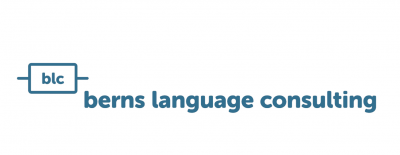How to Integrate Artificial Intelligence (AI) into Language Processes – A blc Success Story.
Initial situation
I don't see the AI forest for the trees
Artificial intelligence promises leaps in efficiency, the replacement of tedious manual workflows – and at the same time raises many questions. Which AI solutions really pay off? What exactly does the use of LLMs, genAI and AI agents mean for my processes and my company?
Our customer, a language team manager at a large German industrial company, felt that the AI world was turning around relentlessly… and that she would either have to turn around, or be left behind with her processes and systems. Her big ambition: to use AI in their processes, but sustainably and with understanding!
Approach
Sift the Chaff from the AI Wheat
In order to separate the proverbial chaff from AI wheat, a strategic analysis with a view to the meta-level helps:
- What basically makes your company? Where is the strategic journey going? What are the strategic corporate objectives?
- Is there an AI business strategy that can and should be built on?
Ideally, AI deployment follows the AI strategy described by the company and the overall corporate goals and pays for them. Unfortunately, in many companies, if at all, there is a rather vague strategy regarding the use of AI and the objectives that are being pursued.
What helps then is to think outside the box:
- What other teams in the company are already doing with AI?
- Are there sparring partners with whom I can be teamed?
- Which AI systems are already available?
- Are these internal solutions or external solutions – keyword data security!
And, of course, your own goals should be examined more closely: Are there any goals that need to be met? Is there a division or team strategy? Often, there are new processes or products in the pipeline that involve different requirements.
Quickly become concrete - but remain in the target picture
The analysis revealed (here shortened greatly) that there was no overall, clear AI strategy at the company level, but an informed IT that could provide LLM variants in a sandbox. In addition, they were on their own.
The goals in the team were relatively clear: Among other things, there was a stakeholder with a new process and extremely high time pressure in terms of translation durations. This process was of high strategic importance to the company.
In the detailed analysis for our customer, we looked at the specific applications for which AI could be used sensibly, effectively, safely and affordably.
Taking into account the realities and the target direction in the team, the use of an AI model for automatic assessment of the quality of machine translation (Quality Risk Estimation, QRE) has emerged as an AI use case.
Good reasons
Why did we choose this?
A good reason: Our customer already has a well-automated, functioning translation process including trained NMT. In order to create very short translation cycles for the new stakeholder project, with the lowest possible quality risk, an AI model can be used to automatically assess translation quality. Depending on the result score, translations are then inserted either into the review or into the production environment.
The second good reason: In addition, the company had the opportunity to fine-tune models with internal data, test them and integrate the results productively into a pipeline.
This translation pipeline with QRE ensures that the stakeholder goals for increasing efficiency are met, while maintaining quality. This has worked so well that we are currently considering rolling this process out to other translation projects.
Result and conclusion
Even if the diverse use of AI seems breathtaking: It only works if the quality of results and data security are guaranteed and it is worth it for customers.
Since we stand for lean language processes, we always have feasibility, quality and costs in mind and help to select the language technology with which the requirements of our customers are really met.
Last but not least, such implementations are most sustainable when they make a concrete contribution to strategic goals in the company. We advocate that companies develop clear strategic AI frameworks in which employees and teams can move safely with their own topics.
Our goal is to create clarity about what is possible and meaningful with AI in the language field – and what is important in order not only to test AI but also to use it productively and efficiently.
Would you like to develop a clear AI strategy with us – efficient, cost-saving and sustainable? Then contact us now – we will be happy to help you!







